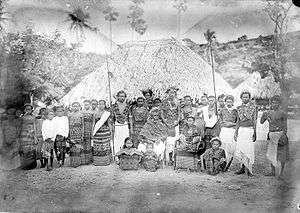Savu people
|
Raja of Liae with his tribe, 1900s. | |
| Total population | |
|---|---|
| (135,000[1]) | |
| Regions with significant populations | |
| Sawu Island, East Nusa Tenggara, Indonesia | |
| Languages | |
| Savu language, Indonesian | |
| Religion | |
| Protestant Christian (predominantly), Jingi Tiu (traditional religion) | |
| Related ethnic groups | |
| Sumba people |
The Savu (also known as Sabu, Sawu or Hawu) people are the people of Savu and smaller neighbouring Raijua in East Nusa Tenggara, Indonesia.
Savu had little to interest traders from Europe, or neighbouring kingdoms, and it remained largely insular until the late-20th century.
Structure
Savu originally had six independent domains, Teriwu, Liae, Dimu, Menia, Seba and Mesara.[2] Menia was defeated by Seba in the 19th century, while Teriwu disappeared much earlier.
A raja and fetor of each domain were appointed by the Dutch during colonial times.
After independence Savu was split into two kecamatan, East Savu (Liae and Dimu) and West Savu (Seba and Mesara plus Raijua).
In the 2000s, the political structure of Savu has been reorganised to more closely reflect traditional lines, which retained local significance over and above the arbitrary divisions imposed by the Indonesian government. The kecamatan now are Hawu Mehara, West Savu, Central Savu, East Savu, Liae, and Raijua.
Genealogy
The Savu people practise bilateral descent, with descendants of one the udu (patrilineal groups) termed kerogo, as well as a matrilineal descendance that is traced to in Savu mythology to one of two sisters. The moiety of the two sisters is termed hubi; the hubi are divided into wini.
Marriage is between a man and a woman of the same wini as his mother, or at a minimum within the same hubi. There is non-reciprocal gift-giving from the groom's family to that of the bride. Wini and hubu play a role in ceremonies such as weddings, funerals and baptisms.
Savu ikat (traditional weaving) reflect many aspects of Savu genealogy, including specific motifs and colours representing the weaver's hubu and wini.[3]
Savu people place importance on genealogy, tracking both hubi and kerogo back through many generations.
Culture
The Savu measure time in units that range from six to 49 years, depending on the domain.
Savu people place great importance on their genealogy, with names chosen to avoid repetition, and genealogies recited during ritual performances such as at funerals, where the connection of the departed to his or her ancestors is memorialised. The memorising of genealogies has also been observed in neighbouring cultures, in Roti and Kedang.
As with many others parts of Indonesia, betel nut is popular, as indeed is tuak, wine made from the sugar palm, as well as the sap, drunk fresh from the tree.[4] The palm tree is treated with great respect, and the apu lodo priest, descendant of the sun supervises the palm tapping season.
Architecture
The Savu house is built on poles,[5] and is designed to resemble a proa boat, with the front beams resembling its bow. There are also anthropomorphic elements in the terminology used to refer to parts of the house.[6]
Jingi Tiu
The traditional religion of Savu is called Jingi Tiu.
Each of the domains of Savu was led by a Jingi Tiu Council of Priests.
Jingi Tiu is a polytheistic religion, with gods of earth, sea and sky, as well as many more minor spirits.
Music
Savu music is based on the gong,[7] and normally accompanies traditional dance. The Padoa dance is performed in a circle, holding hands, with dancers rotating their legs clockwise, wearing pedue (beans wrapped in palm leaf to create a rattle). The Ledo Hua dance is performed by mixed pairs, with the men wearing bells.
Protestantism
Evangelism began in 1854, and increased its impetus after 1861, when Esser, Dutch resident of Kupang, called for schools and a Christian teacher from Ambon in Savu.[8] Since the 1970s, when the Indonesian encouraged people throughout Indonesia to adopt Islam or Christianity, Protestantism has been in the ascendancy, with 80% of Savu people now Protestan, and Jingi Tiu on the decline. Despite this, many aspects of Jingi Tiu belief still influence Christian worship in Savu.
References
- ↑ "Sabu in Indonesia". PeopleGroup.org. Retrieved 2014-09-24.
- ↑ http://www.kitlv-journals.nl/index.php/jissh/article/viewFile/URN%3ANBN%3ANL%3AUI%3A10-1-100162/8444
- ↑ http://www.kitlv-journals.nl/index.php/btlv/article/viewFile/3100/3861
- ↑ http://www.thejakartaglobe.com/travel/history-and-lethargy-on-sabu-island/378141
- ↑ "Rumah Adat Sawu or Savu". Panoramio. Retrieved 2015-01-21.
- ↑ http://kitlv.library.uu.nl/index.php/btlv/article/viewFile/1785/2546
- ↑ http://www.kab-kupang.go.id/tour/esabuculture.htm
- ↑ Catholics in Indonesia: 1808 - 1942 : a documented history
External links
| Wikimedia Commons has media related to Savu. |
